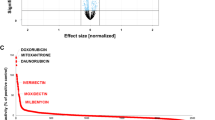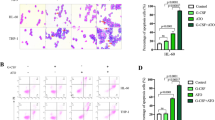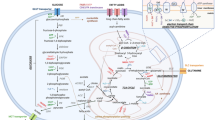Abstract
Purpose
Pyrvinium pamoate (PP) is an anthelmintic drug that has been found to have anti-cancer activity in several cancer types. In the present study, we evaluated PP for potential anti-leukemic activity in B cell acute lymphoblastic leukemia (ALL) cell lines, in an effort to evaluate the repurposing potential of this drug in leukemia.
Methods
ALL cells were treated with PP at various concentrations to determine its effect on cell proliferation. Metabolic function was tested by evaluating Extracellular Acidification Rate (ECAR) and Oxygen Consumption Rate (OCR). Lastly, 3D spheroids were grown, and PP was reformulated into nanoparticles to evaluate distribution effectiveness.
Results
PP was found to inhibit ALL proliferation, with varied selectivity to different ALL cell subtypes. We also found that PP’s cell death activity was specific for leukemic cells, as primary normal immune cells were resistant to PP-mediated cell death. Metabolic studies indicated that PP, in part, inhibits mitochondrial oxidative phosphorylation. To increase the targeting of PP to a hypoxic bone tumor microenvironment (BTME) niche, we successfully encapsulated PP in a nanoparticle drug delivery system and demonstrated that it retained its anti-leukemic activity in a hemosphere assay.
Conclusion
We have demonstrated that PP is a novel therapeutic lead compound that counteracts the respiratory reprogramming found in refractory ALL cells and can be effectively formulated into a nanoparticle delivery system to target the BTME.







Similar content being viewed by others
Abbreviations
- 2-DG:
-
2-deoxyglucose
- ALL:
-
B cell acute lymphoblastic leukemia
- ATP:
-
Adenosine triphosphate
- BM:
-
Bone marrow
- BMSC:
-
Bone marrow stromal cells
- BTME:
-
Bone tumor microenvironment
- ECAR:
-
Extracellular acidification rate
- ETC:
-
Electron transport chain
- FBS:
-
Fetal bovine serum
- FCCP:
-
Carbonyl cyanide 4-(trifluoromethoxy) phenylhydrazone
- HK2:
-
Hexokinase II
- HOB:
-
Human osteoblasts
- IPA:
-
Ingenuity Pathway Analysis
- M:
-
Monoculture
- MRD:
-
Minimal residual disease
- NP:
-
Nanoparticles
- OCR:
-
Oxygen consumption rate
- OXPHOS:
-
Oxidative phosphorylation
- PD:
-
Phase dim, buried co-culture ALL cells
- PP:
-
Pyrvinium pamoate
- TBS:
-
Tris-buffered saline
- S:
-
Co-culture ALL cells in suspension
References
Pui CH, Relling MV, Downing JR. Acute lymphoblastic leukemia. N Engl J Med. 2004;350(15):1535–48.
Espinoza-Hernandez L, Cruz-Rico J, Benitez-Aranda H, Martinez-Jaramillo G, Rodriguez-Zepeda MC, Velez-Ruelas MA, et al. In vitro characterization of the hematopoietic system in pediatric patients with acute lymphoblastic leukemia. Leuk Res. 2001;25(4):295–303.
Malouf C, Ottersbach K. Molecular processes involved in B cell acute lymphoblastic leukaemia. Cell Mol Life Sci. 2018;75(3):417–46.
Hunger SP, Lu X, Devidas M, Camitta BM, Gaynon PS, Winick NJ, et al. Improved survival for children and adolescents with acute lymphoblastic leukemia between 1990 and 2005: a report from the children's oncology group. J Clin Oncol. 2012;30(14):1663–9.
Fielding AK, Richards SM, Chopra R, Lazarus HM, Litzow MR, Buck G, et al. Medical Research Council of the United Kingdom adult ALLWP, Eastern Cooperative Oncology G. outcome of 609 adults after relapse of acute lymphoblastic leukemia (ALL); an MRC UKALL12/ECOG 2993 study. Blood. 2007;109(3):944–50.
Pogorzala M, Kubicka M, Rafinska B, Wysocki M, Styczynski J. Drug-resistance profile in multiple-relapsed childhood acute lymphoblastic leukemia. Anticancer Res. 2015;35(10):5667–70.
Sutton R, Venn NC, Tolisano J, Bahar AY, Giles JE, Ashton LJ, et al. Australian, New Zealand Children's Oncology G. clinical significance of minimal residual disease at day 15 and at the end of therapy in childhood acute lymphoblastic leukaemia. Br J Haematol. 2009;146(3):292–9.
Borowitz MJ, Devidas M, Hunger SP, Bowman WP, Carroll AJ, Carroll WL, et al. Clinical significance of minimal residual disease in childhood acute lymphoblastic leukemia and its relationship to other prognostic factors: a Children's Oncology Group study. Blood. 2008;111(12):5477–85.
Slone WL, Moses BS, Evans R, Piktel D, Martin KH, Petros W, et al. Modeling chemotherapy resistant leukemia in vitro. J Vis Exp. 2016;108:e53645.
Moses BS, Slone WL, Thomas P, Evans R, Piktel D, Angel PM, et al. Bone marrow microenvironment modulation of acute lymphoblastic leukemia phenotype. Exp Hematol. 2016;44(1):50-59 e51-52.
Moses BS, Evans R, Slone WL, Piktel D, Martinez I, Craig MD, et al. Bone marrow microenvironment niche regulates miR-221/222 in acute lymphoblastic leukemia. Mol Cancer Res. 2016;14(10):909–19.
Slone WL, Moses BS, Hare I, Evans R, Piktel D, Gibson LF. BCL6 modulation of acute lymphoblastic leukemia response to chemotherapy. Oncotarget. 2016;7(17):23439–53.
Ishii I, Harada Y, Kasahara T. Reprofiling a classical anthelmintic, pyrvinium pamoate, as an anti-cancer drug targeting mitochondrial respiration. Front Oncol. 2012;2:137.
Tomitsuka E, Kita K, Esumi H. An anticancer agent, pyrvinium pamoate inhibits the NADH-fumarate reductase system--a unique mitochondrial energy metabolism in tumour microenvironments. J Biochem. 2012;152(2):171–83.
Bosc C, Selak MA, Sarry JE. Resistance is futile: targeting mitochondrial energetics and metabolism to overcome drug resistance in cancer treatment. Cell Metab. 2017;26(5):705-07.
Weinberg SE, Chandel NS. Targeting mitochondria metabolism for cancer therapy. Nat Chem Biol. 2015;11(1):9-15.
Harada Y, Ishii I, Hatake K, Kasahara T. Pyrvinium pamoate inhibits proliferation of myeloma/erythroleukemia cells by suppressing mitochondrial respiratory complex I and STAT3. Cancer Lett. 2012;319(1):83-8.
Liao Y, Smyth GK, Shi W. The subread aligner: fast, accurate and scalable read mapping by seed-and-vote. Nucleic Acids Res. 2013;41(10):e108.
Tarazona S, Garcia-Alcalde F, Dopazo J, Ferrer A, Conesa A. Differential expression in RNA-seq: a matter of depth. Genome Res. 2011;21(12):2213–23.
Tarazona S, Furio-Tari P, Turra D, Pietro AD, Nueda MJ, Ferrer A, et al. Data quality aware analysis of differential expression in RNA-seq with NOISeq R/Bioc package. Nucleic Acids Res. 2015;43(21):e140.
Love MI, Huber W, Anders S. Moderated estimation of fold change and dispersion for RNA-seq data with DESeq2. Genome Biol. 2014;15(12):550.
Shepherd DL, Hathaway QA, Pinti MV, Nichols CE, Durr AJ, Sreekumar S, et al. Exploring the mitochondrial microRNA import pathway through polynucleotide Phosphorylase (PNPase). J Mol Cell Cardiol. 2017;110:15–25.
Hathaway QA, Nichols CE, Shepherd DL, Stapleton PA, McLaughlin SL, Stricker JC, et al. Maternal-engineered nanomaterial exposure disrupts progeny cardiac function and bioenergetics. Am J Physiol Heart Circ Physiol. 2017;312(3):H446–58.
Nair RR, Piktel D, Geldenhuys WJ, Gibson LF. Combination of cabazitaxel and plicamycin induces cell death in drug resistant B-cell acute lymphoblastic leukemia. Leuk Res. 2018;72:59–66.
Yin C, He D, Chen S, Tan X, Sang N. Exogenous pyruvate facilitates cancer cell adaptation to hypoxia by serving as an oxygen surrogate. Oncotarget. 2016;7(30):47494–510.
Barrientos A, Moraes CT. Titrating the effects of mitochondrial complex I impairment in the cell physiology. J Biol Chem. 1999;274(23):16188–97.
Petrova V, Annicchiarico-Petruzzelli M, Melino G, Amelio I. The hypoxic tumour microenvironment. Oncogenesis. 2018;7(1):10.
Tchoryk A, Taresco V, Argent RH, Ashford M, Gellert PR, Stolnik S, et al. Penetration and uptake of nanoparticles in 3D tumor spheroids. Bioconjug Chem. 2019;30(5):1371–84.
Harada Y, Ishii I, Hatake K, Kasahara T. Pyrvinium pamoate inhibits proliferation of myeloma/erythroleukemia cells by suppressing mitochondrial respiratory complex I and STAT3. Cancer Lett. 2012;319(1):83–8.
Xiang W, Cheong JK, Ang SH, Teo B, Xu P, Asari K, et al. Pyrvinium selectively targets blast phase-chronic myeloid leukemia through inhibition of mitochondrial respiration. Oncotarget. 2015;6(32):33769–80.
Mullighan CG, Goorha S, Radtke I, Miller CB, Coustan-Smith E, Dalton JD, et al. Genome-wide analysis of genetic alterations in acute lymphoblastic leukaemia. Nature. 2007;446(7137):758–64.
Chan LN, Chen Z, Braas D, Lee JW, Xiao G, Geng H, et al. Metabolic gatekeeper function of B-lymphoid transcription factors. Nature. 2017;542(7642):479–83.
Iwama Y, Eguchi M. Quantitative evaluation of leukemic mitochondria with a computer-controlled image analyzer. Virchows Arch B Cell Pathol Incl Mol Pathol. 1986;51(5):375–84.
Boag JM, Beesley AH, Firth MJ, Freitas JR, Ford J, Hoffmann K, et al. Altered glucose metabolism in childhood pre-B acute lymphoblastic leukaemia. Leukemia. 2006;20(10):1731–7.
Mathupala SP, Rempel A, Pedersen PL. Glucose catabolism in cancer cells: identification and characterization of a marked activation response of the type II hexokinase gene to hypoxic conditions. J Biol Chem. 2001;276(46):43407–12.
Fu X, Liu W, Huang Q, Wang Y, Li H, Xiong Y. Targeting mitochondrial respiration selectively sensitizes pediatric acute lymphoblastic leukemia cell lines and patient samples to standard chemotherapy. Am J Cancer Res. 2017;7(12):2395–405.
Carrella D, Manni I, Tumaini B, Dattilo R, Papaccio F, Mutarelli M, et al. Computational drugs repositioning identifies inhibitors of oncogenic PI3K/AKT/P70S6K-dependent pathways among FDA-approved compounds. Oncotarget. 2016;7(37):58743–58.
Lim M, Otto-Duessel M, He M, Su L, Nguyen D, Chin E, et al. Ligand-independent and tissue-selective androgen receptor inhibition by pyrvinium. ACS Chem Biol. 2014;9(3):692–702.
Esumi H, Lu J, Kurashima Y, Hanaoka T. Antitumor activity of pyrvinium pamoate, 6-(dimethylamino)-2-[2-(2,5-dimethyl-1-phenyl-1H-pyrrol-3-yl)ethenyl]-1-methyl-qu inolinium pamoate salt, showing preferential cytotoxicity during glucose starvation. Cancer Sci. 2004;95(8):685–90.
Xu F, Zhu Y, Lu Y, Yu Z, Zhong J, Li Y, et al. Anthelmintic pyrvinium pamoate blocks Wnt/beta-catenin and induces apoptosis in multiple myeloma cells. Oncol Lett. 2018;15(4):5871–8.
Smith TC, Kinkel AW, Gryczko CM, Goulet JR. Absorption of pyrvinium pamoate. Clin Pharmacol Ther. 1976;19(6):802–6.
Jones JO, Bolton EC, Huang Y, Feau C, Guy RK, Yamamoto KR, et al. Non-competitive androgen receptor inhibition in vitro and in vivo. Proc Natl Acad Sci U S A. 2009;106(17):7233–8.
Carroll RT, Bhatia D, Geldenhuys W, Bhatia R, Miladore N, Bishayee A, et al. Brain-targeted delivery of Tempol-loaded nanoparticles for neurological disorders. J Drug Target. 2010;18(9):665–74.
Loskutov YV, Griffin CL, Marinak KM, Bobko A, Margaryan NV, Geldenhuys WJ, et al. LPA signaling is regulated through the primary cilium: a novel target in glioblastoma. Oncogene. 2018;37(11):1457–71.
Raez LE, Papadopoulos K, Ricart AD, Chiorean EG, Dipaola RS, Stein MN, et al. A phase I dose-escalation trial of 2-deoxy-D-glucose alone or combined with docetaxel in patients with advanced solid tumors. Cancer Chemother Pharmacol. 2013;71(2):523–30.
Martinez-Outschoorn UE, Pestell RG, Howell A, Tykocinski ML, Nagajyothi F, Machado FS, et al. Energy transfer in "parasitic" cancer metabolism: mitochondria are the powerhouse and Achilles' heel of tumor cells. Cell Cycle. 2011;10(24):4208–16.
ACKNOWLEDGMENTS AND DISCLOSURES
The authors would like to acknowledge Kathleen Brundage, director of the WVU Flow Cytometry & Single Cell Core Facility, for her assistance in acquisition of the flow cytometry data and Aniello Infante, lead bioinformatician with the WVU Genomics Core Facility, for his assistance with gene expression analysis. This work was supported by the Alexander B. Osborn Hematopoietic Malignancy and Transplantation Program, Community Foundation for the Ohio Valley Whipkey Trust, NIH grants U54GM104942, P30GM103488, P20GM103434, RO1HL128485, S10OD016165, R42AR074812, R44CA221554, R41NS110070 and P20 GM109098; and AHA grant 17PRE33660333. The authors declare that they have no conflicts of interest with the contents of this manuscript.
Author information
Authors and Affiliations
Corresponding author
Additional information
Publisher’s Note
Springer Nature remains neutral with regard to jurisdictional claims in published maps and institutional affiliations.
Electronic Supplementary Material
ESM1
(DOCX 1143 kb)
Rights and permissions
About this article
Cite this article
Nair, R.R., Piktel, D., Hathaway, Q.A. et al. Pyrvinium Pamoate Use in a B cell Acute Lymphoblastic Leukemia Model of the Bone Tumor Microenvironment. Pharm Res 37, 43 (2020). https://doi.org/10.1007/s11095-020-2767-4
Received:
Accepted:
Published:
DOI: https://doi.org/10.1007/s11095-020-2767-4




